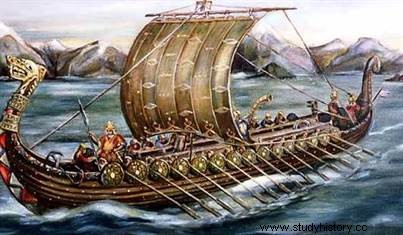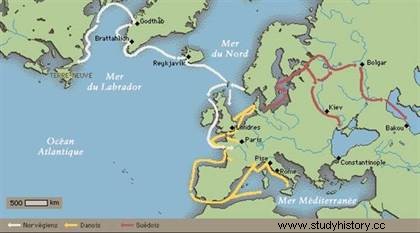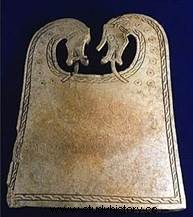 The Vikings , “warriors of the sea”, are maritime and conquering peoples who came from Scandinavia and who, from the end of the 8th century until the 12th century, engaged in incursions on the coasts of Europe and along the rivers. In the Carolingian period, they were given the name “Normans”, from Nortmanni, “men of the North”. Their expansion can be considered as the last wave of the great Germanic invasions:it led to the constitution by the Normans of several lasting states, centers of brilliant civilization, in Normandy, England, Sicily and in southern Italy, in Russia.
The Vikings , “warriors of the sea”, are maritime and conquering peoples who came from Scandinavia and who, from the end of the 8th century until the 12th century, engaged in incursions on the coasts of Europe and along the rivers. In the Carolingian period, they were given the name “Normans”, from Nortmanni, “men of the North”. Their expansion can be considered as the last wave of the great Germanic invasions:it led to the constitution by the Normans of several lasting states, centers of brilliant civilization, in Normandy, England, Sicily and in southern Italy, in Russia.
Origin of the Vikings
The origin of the word viking is multiple:the ancient Scandinavians called "víkingar", those among them who went on warlike expeditions over the seas while the expression "fara í víkingu" - going on an expedition - is common in the sagas. But the term Viking can also be compared with the word “vík” which designates the bay, with the verb “vikja” which means to run on the edges or with the Latin vicus, the village.
The Vikings appeared in the 6th century AD, and were first known to be traders, fishermen and above all remarkable carpenters. They were by no means barbarians dreaming only of stupid destruction; they were the heirs of an already thousand-year-old civilization, of heroic and religious traditions which were to be recorded in the Eddas (10th to 11th centuries). Many poems and songs have been found, written in Old Norse (the language of the Vikings) which describe their civilization marked by an original religion, dominated by the gods Odin, god of War, and Thor, god of Thunder.
 In the regions where they settled by conquest, they showed a remarkable sense of adaptation to local situations , while preserving a completely original physiognomy for their States. Their military superiority resided above all in their maritime technique:as they used to bury their dead in their boats (snekkjur), we were able to find some of these ships in a perfect state of preservation (ships of Gokstad, Oseberg) . Undecked, suitable for fairly short crossings, they could easily go up the course of rivers. However, they were also able to face voyages (the Gokstad ship, exactly rebuilt, completed the Atlantic crossing without incident in 1893).
In the regions where they settled by conquest, they showed a remarkable sense of adaptation to local situations , while preserving a completely original physiognomy for their States. Their military superiority resided above all in their maritime technique:as they used to bury their dead in their boats (snekkjur), we were able to find some of these ships in a perfect state of preservation (ships of Gokstad, Oseberg) . Undecked, suitable for fairly short crossings, they could easily go up the course of rivers. However, they were also able to face voyages (the Gokstad ship, exactly rebuilt, completed the Atlantic crossing without incident in 1893).
The first Viking raids
The Viking invasions seem to have had various causes:worsening climatic conditions, demographic pressure in Scandinavia, lack of land, establishment of the first monarchies, before which many nobles rebelled, and preferred to go away rather than submit.
Even though current historians assume the first Viking movements were much earlier, the first known Viking raid aboard their knörr or skeid (not "drakkar") was carried out in 793 by Norwegian sailors on the holy island of Lindisfarne, off the northeast tip of England. High-performance ocean-going vessels, Viking ships are also capable of navigating rivers and streams, thanks to a shallow-draft hull. They are propelled by both oars and sails. The name improperly given to the Viking ship, "drakkar", is derived from the Swedish word drakar, itself plural of drake, which means "dragon". The figurehead that adorns the drakkars represents a dragon, a symbol of power, whose purpose is to protect ships and their men when they approach enemy coasts.
It was in these warships that the Vikings made successful raids on the coasts of Western Europe. Then, in the 9th century, Swedish navigators penetrated into the heart of Russia, discovering new trade routes along the Volga and the Dnieper to the Black Sea, founding city-states like kyiv and Novgorod, and paving the way to Constantinople and the exotic markets of Arabia and the Far East. Known as the Varangians in Eastern Europe, these Vikings formed the elite bodyguard of the Byzantine Emperors.
A Scandinavian empire in northern Europe
Soon, Danes attack the cities of the Carolingian Empire in decline (Hamburg, Dorestad, Rouen, Paris, Nantes, Bordeaux). Finally, in 911, a treaty will be signed granting them vast territories in northern France (current Normandy, “country of the Normans”) where they will settle. From the 10th century, raids became rarer because most of the Vikings had converted to Christianity; they are therefore forbidden to take slaves in Christian countries.
 Under the reign of Knutt (or Canute) the Great, in the 11th century, a Norse Empire of the Sea of North is erected, comprising England, Denmark and Norway. The Norwegian adventurers join the Danes in subduing the whole of northern England (the Danelaw). They settled there as farmers or traders and developed large cities like York. Despite the resistance of the Anglo Saxons, they also seized the Shetland and Orkney Islands, the Hebrides and most of Scotland.
Under the reign of Knutt (or Canute) the Great, in the 11th century, a Norse Empire of the Sea of North is erected, comprising England, Denmark and Norway. The Norwegian adventurers join the Danes in subduing the whole of northern England (the Danelaw). They settled there as farmers or traders and developed large cities like York. Despite the resistance of the Anglo Saxons, they also seized the Shetland and Orkney Islands, the Hebrides and most of Scotland.
In Ireland, they played an active role in deadly feuds between rival Irish clans, and built Ireland's first trading cities (Dublin, Waterford, Wexford, Wicklow and Limerick ).
Vikings storm the Carolingian Empire
While the Carolingian Empire was strong, the Normans avoided attacking it and led their expeditions against Ireland and Britain. But, after the death of Louis the Pious, the weakness of Francia occidentalis increased their audacity, and they multiplied their raids on the coasts of the North Sea, the English Channel and the Atlantic.
Moving up the rivers, the invaders swooped down on cities and abbeys, looting treasures, leaving dead, ruins and ashes in their path. In 843, a hundred longships sailed up the Loire, and the Normans attacked Nantes:the bishop, who was celebrating mass in the city's cathedral, was massacred. Some of the “Men of the North” settled on the island of Noirmoutier and did not return to spend the winter in Scandinavia:for the first time, they settled permanently in France. Others followed their example and settled with women and children in several coastal regions. Their expeditions also aimed at Aquitaine. Finally, on several occasions, the Normans went up the Seine and besieged Paris.
In 845, a powerful fleet commanded by Ragnar Lodbrok captured the city, abandoned by its inhabitants, and King Charles the Bald negotiated their departure against the payment of a tribute of 7,000 pounds of silver, a method he had to use again in the following years, during new invasions. So he decided to build bridges fortified by the first capitular of Pitres (June 862) and fortified enclosures by the second (June 864), in order to put an end to these raids. In 876, a Norman army driven out of England ravaged the north of the Frankish kingdom and came to lay siege to Paris, which resisted valiantly under the leadership of its Count Eudes.
It was not until the reign of Charles III the Simple that the Norman incursions were finally put to an end, the last of which had begun in 896, under the direction of the Viking chief Rollo. The invaders had firmly established themselves in the region of Rouen and Charles the Simple began negotiations with their leader which led to the Treaty of Saint Clair sur Epte (911). The lands where the Normans had settled between the Epte and the Channel constituted the Duchy of Normandy, Rollo was baptized and married the daughter of the Count of Bayeux. His descendant William the Conqueror became the most famous of the Dukes of Normandy by seizing the crown of England.
Discovery of America and Viking Legacy
The Vikings discover and settle in the uninhabited lands of the Atlantic, the Faroes, then Iceland and Greenland. It was from the latter that they launched ambitious expeditions to establish themselves on the eastern coast of North America. Leif Eriksson, son of Erik the red would thus have led an expedition to a land he baptized Vinland (perhaps Newfoundland). But these attempts to colonize the New World - five centuries before Christopher Columbus - were quickly abandoned in the face of the hostility of the natives. This abortive conquest of America is found in medieval Icelandic sagas.
The great capacity of assimilation of the Vikings to the local populations leaves little room for a real influence of these peoples of the North. A century and a half after their establishment in Normandy, the Franco-Viking descendants seized England (William the Conqueror, 1066), and Sicily (Robert Guiscard and his brother Roger I, 1060-1090).
 Settlers brought to the British Isles new forms of art, innovative farming techniques, business skills and a vigorous language (Scandinavian vestiges are still visible in the dialects of Scotland and northern England). They also introduce forms of administration and justice, such as the jury principle. Moreover, the word law comes from Norse. Perhaps the most enduring legacy of the Viking Age is found in Iceland, which produced the great medieval sagas literature. The role of the Vikings in history is very important since they integrated the countries of the North and the Baltic Sea into Europe, laid the foundations of the future Russia and left important traces in Ireland, as well as in England and France.
Settlers brought to the British Isles new forms of art, innovative farming techniques, business skills and a vigorous language (Scandinavian vestiges are still visible in the dialects of Scotland and northern England). They also introduce forms of administration and justice, such as the jury principle. Moreover, the word law comes from Norse. Perhaps the most enduring legacy of the Viking Age is found in Iceland, which produced the great medieval sagas literature. The role of the Vikings in history is very important since they integrated the countries of the North and the Baltic Sea into Europe, laid the foundations of the future Russia and left important traces in Ireland, as well as in England and France.
Bibliography
- The Vikings, by Régis Boyer. Tempus, 2015.
- In the Age of the Vikings, by Anders Winroth. Discovery, 2018.
- The Vikings Saga:Another History of Invasions, by Joël Supéry. Otherwise, 2018.
